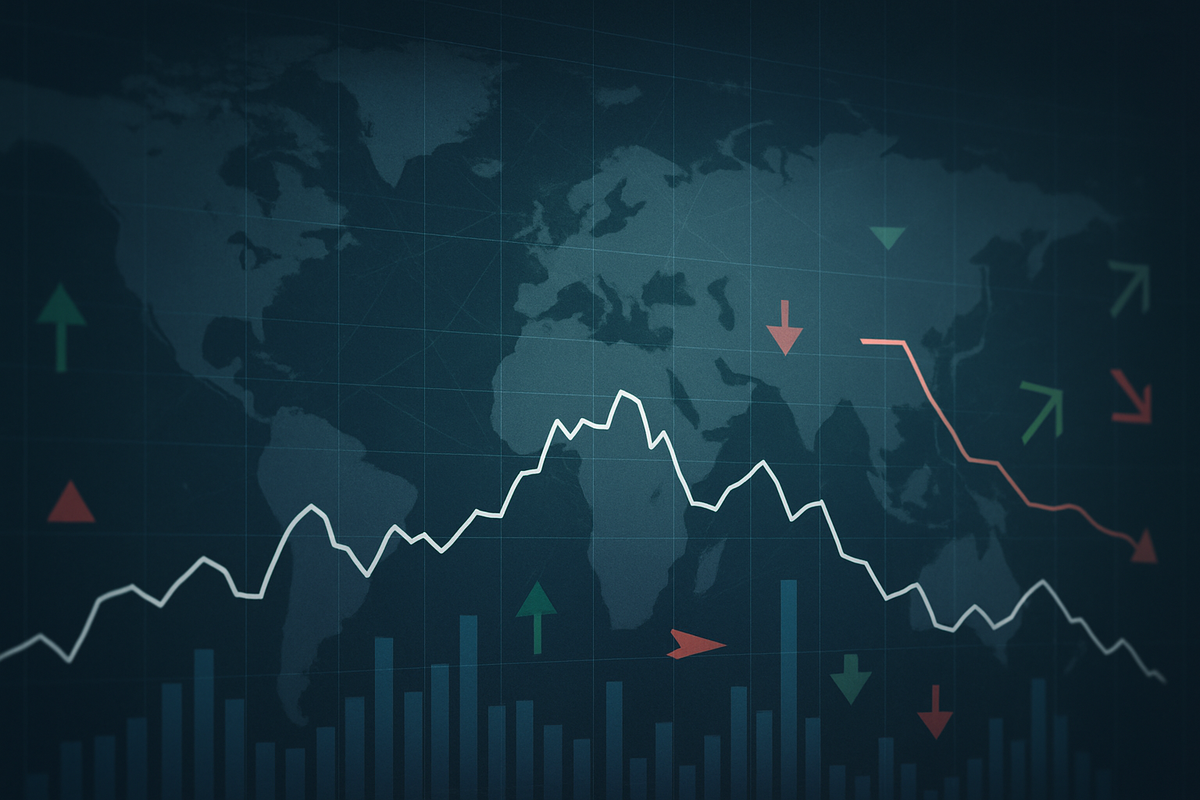
On a recent trading day, the German stock market concluded with a mixed performance, seeing its benchmark DAX index (XTRA: DAX) register a modest decline of 0.15% at the close. This slight dip underscores a period of heightened caution and uncertainty among investors, as a confluence of global economic indicators, geopolitical developments, and nuanced central bank policies continues to shape market sentiment. The mixed close reflects a divergence in sectoral performance, where some companies managed to hold steady or even gain, while others faced headwinds, painting a complex picture for Europe's largest economy.
The marginal downturn in the DAX is indicative of a market grappling with multiple, often conflicting, forces. Germany's heavily export-oriented economy means its stock market is acutely sensitive to global trade flows and international economic health. Recent data showing both strengths and weaknesses across major global economies, coupled with fluctuating currency values, has created an environment where broad-based rallies are difficult to sustain. Furthermore, the European Central Bank's (ECB) delicate balancing act between stimulating growth and containing inflation, especially with Germany's annual inflation rate climbing to 2.4% in September 2025, injects a layer of uncertainty regarding future monetary policy. This environment encourages selective investing rather than a uniform market direction.
Navigating the Nuances: A Closer Look at the Day's Trading
The day's trading saw a fascinating interplay of factors contributing to the DAX's slight retreat. While no single catastrophic event triggered a sharp sell-off, a combination of subtle pressures led to the index's mixed performance. Global economic sentiment, often a bellwether for German exports, presented a mixed bag. Reports of robust growth in some key trading partners were offset by concerns over fragility in others, creating a cautious mood. The Euro's (EURUSD) performance against major currencies also played a role; a stronger Euro can make German exports more expensive, potentially impacting the profit margins of multinational corporations listed on the DAX.
Interest rate expectations further complicated the picture. While the ECB had previously adopted an accommodative stance, cutting rates to 2% earlier in 2025 due to slowing inflation, it held rates steady in late September 2025 amid renewed inflation concerns. This pivot, or rather, a pause in rate cuts, has created a nuanced outlook for various sectors. Companies sensitive to borrowing costs, such as financials, reacted differently than those benefiting from sustained economic activity. Geopolitical tensions, particularly the ongoing conflict in Ukraine, instability in the Middle East, and persistent trade disputes, continued to loom large, adding a layer of risk aversion. With 76% of DAX constituent companies' assets located abroad, these global flashpoints have a direct bearing on their operational stability and revenue streams.
Winners and Losers: Corporate Fortunes Amidst Market Flux
The mixed market performance naturally created a divide between companies that either defied the slight downturn or contributed to it. Sectors poised for growth or benefiting from specific tailwinds saw resilience, while others, particularly those highly sensitive to interest rates or trade disruptions, experienced pressure.
On the positive side, defense and industrial giants, benefiting from Germany's substantial €1 trillion fiscal stimulus plan aimed at defense modernization and infrastructure, showed strength. Companies like Rheinmetall AG (XTRA: RHM) and Airbus (XTRA: AIR) have been key beneficiaries. Technology and AI innovators also demonstrated robust performance. SAP (XTRA: SAP), the largest DAX constituent, continued to leverage its leadership in cloud computing and AI-driven enterprise solutions, with its global client base fueling consistent growth. Similarly, Siemens (XTRA: SIE) has seen gains from government-funded projects in clean energy grids and cybersecurity. Utilities and healthcare sectors, often considered defensive during uncertain times, also found favor, with E.ON (XTRA: EOAN) rebounding on expectations of potential future ECB rate cuts and declining energy costs.
Conversely, some sectors faced headwinds. While the financial sector has seen a rebound in parts, lower interest rates can traditionally squeeze Net Interest Margins (NIMs) for banks, impacting profitability. Commerzbank (XTRA: CBK), despite some recent gains, has on certain days experienced pressure. Export-oriented and cyclical firms, particularly those highly sensitive to trade tensions and global demand fluctuations, also lagged. German manufacturers, especially in the automotive industry like Volkswagen (XTRA: VOW3) and Porsche (XTRA: P911), remain vulnerable to disruptions in global trade flows and the lingering impact of tariffs, even if reduced, on their key markets. Energy-intensive industries, despite a general easing of energy prices, still face volatility risks that can erode margins.
Wider Implications: Germany's Role in a Shifting Global Economy
The day's mixed market close for the DAX is more than just a daily blip; it reflects Germany's intricate position within broader industry trends and the global economic landscape. As an economic powerhouse in Europe, Germany's market performance often serves as a barometer for the health of the wider Eurozone. The event highlights the ongoing tension between domestic economic stagnation, which saw Germany's growth described as "fragile" in Q3 2025 despite a Eurozone GDP rebound, and the DAX's ability to reach record highs, largely driven by the global exposure of its constituent companies.
The divergence in monetary policy between the ECB and the US Federal Reserve (Fed), with the latter cutting rates due to a cooling labor market, is reshaping currency dynamics and capital flows. This could potentially make European equities relatively more appealing to international investors seeking yield in a lower-rate environment, but it also introduces volatility. Geopolitical risks, from the enduring Ukraine conflict to Middle East tensions and ongoing trade disputes, continue to cast a long shadow, disproportionately affecting Germany's manufacturing and export-dependent sectors. Regulatory or policy implications could arise from the ongoing inflation debate, potentially leading to further adjustments in ECB policy that would ripple through the market, impacting borrowing costs and investment decisions across the continent. Historically, periods of such mixed signals often precede significant shifts in market leadership or economic policy adjustments, requiring investors to remain agile.
What Comes Next: Navigating Opportunities and Challenges
Looking ahead, the German market is poised for continued volatility, but also potential opportunities. In the short-term, investors will be closely watching upcoming economic data, particularly inflation figures and manufacturing output reports, for clearer signals on the ECB's future monetary policy direction. Any decisive move by the ECB, whether a rate cut or a more hawkish stance, will undoubtedly trigger significant market reactions. Geopolitical developments, especially those impacting global trade routes and energy supplies, will also remain critical drivers of sentiment. Companies with strong balance sheets and diversified global revenue streams are likely to weather these uncertainties better.
In the long-term, German companies will need to adapt strategically. The emphasis on clean energy grids, cybersecurity, and AI-driven solutions, fueled by government initiatives, presents significant growth avenues. Companies that can innovate and capture market share in these emerging sectors are likely to be long-term winners. However, challenges persist for traditional industries facing disruption from rapid technological advancements and those heavily reliant on stable global supply chains. Market opportunities may emerge in sectors benefiting from sustainable infrastructure development and digitalization. Conversely, companies unable to pivot away from energy-intensive or less innovative business models may face sustained pressure. Potential scenarios range from a gradual recovery driven by global economic stabilization and favorable ECB policy to continued choppy trading if geopolitical tensions escalate or inflation proves more stubborn than anticipated.
Comprehensive Wrap-Up: Key Takeaways and Investor Outlook
The recent mixed close of the German stock market, with the DAX down a modest 0.15%, serves as a potent reminder of the complex and interconnected nature of today's financial markets. Key takeaways include the profound influence of global economic sentiment and geopolitical events on Germany's export-driven economy, the significant impact of central bank policies on sectoral performance, and the growing divergence in fortunes between innovative, globally diversified companies and those more susceptible to traditional headwinds.
Moving forward, the market is likely to remain dynamic, characterized by selective opportunities rather than broad-based rallies. Investors should assess companies based on their resilience to external shocks, their adaptability to technological shifts, and their exposure to favorable policy initiatives. What investors should watch for in the coming months includes the ECB's monetary policy decisions, global inflation trends, the resolution or escalation of geopolitical conflicts, and the performance of key trading partners. A discerning approach, focusing on fundamentally strong companies in growth sectors, will be crucial for navigating the evolving landscape of the German stock market.
This content is intended for informational purposes only and is not financial advice





